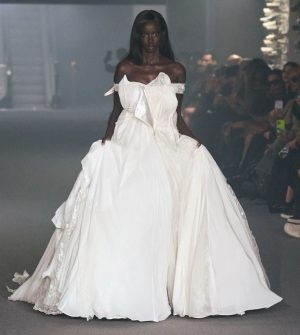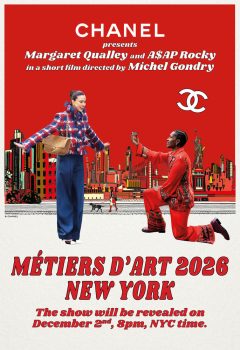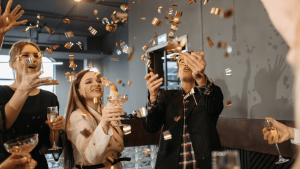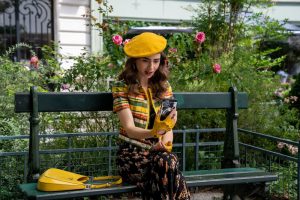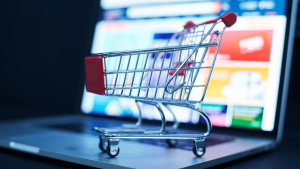In 2016, when Mark Zuckerberg met top executives and politicians in Washington, D.C., including former U.S. President Barack Obama, he dressed in a t-shirt and jeans. While this fits in the “smart casual” dress code for a tech startup, it is not appropriate for a formal business meeting. The Lesson: executives must understand the context of Business Casual vs. Smart Casual. Let us read on.

Business Casual vs Smart Casuals (Image credits: Hugo Boss and Gucci)
Smart casual merges polished and relaxed elements, often characterised by tailored pieces paired with stylish, comfortable items. On the other hand, business casual emphasises professionalism with a more relaxed approach than traditional corporate attire, focusing on slacks, button-down shirts, sans ties or blazers.
It is important to know what a dress code demands. When individuals dress appropriately for the occasion, it reflects their understanding of the environment and boosts their confidence.
For instance, arriving at a networking event in smart casual attire conveys creativity and approachability whereas business casual attire in a formal meeting signals respect for the occasion and the people involved. Over time, these first impressions can cement one’s reputation within a professional community.
This article aims to demystify the distinction between smart casual and business casual, empowering readers to navigate workplace occasions with ease.
Whether attending a job interview, a corporate event, or a relaxed social gathering, understanding the differences in these dress codes will help make informed choices
Smart Casual vs. Business Casual: What’s the Difference?
Business casual leans towards professional attire, requiring structured pieces like blazers, dress pants, and formal shoes. Smart casual, on the other hand, is flexible and allows for personal style.
Example: A marketing executive attending a corporate meeting would wear business casual i.e. blazer, dress pants and Oxford shoes whereas at a company dinner, they might switch to smart casual i.e. chinos, a stylish sweater and dress sneakers. For example, dark denim and sneakers might be acceptable in smart casual settings but may be informal for a business casual office.
A rule of thumb is to ask: “Would I wear this to a client meeting?” If the answer is no, it’s more likely smart casual than business casual. Many industries blur the lines between these two styles, so it’s always best to assess company culture before deciding what to wear.
How to Dress Right for Every Occasion
- Dressing for Work and Business Meetings
- Business casual is the default choice for professional environments.
- Tips: Stick to neutral colours, minimal accessories, and tailored fits.

Business casual is the default choice for professional environments.
- Dressing for Networking and Semi-Formal Events
- Choose business casual if attending corporate networking sessions.
- For startup and creative industry events, smart casual works best.
- Dressing for Social and Casual Work Events
- Smart casual is ideal for team outings, dinner with colleagues, or work retreats.
- Example: Swap formal shirts for polo shirts and structured pants for dark jeans.
- Dressing for Travel and Remote Work
- Business casual is best for business travel particularly for meetings and presentations.
- Smart casual works for remote work and casual Fridays.

Business casual is best for business travel particularly for meetings and presentations
Case Studies: How Industry Professionals Adapt Their Wardrobes
Case Study 1: A Finance Executive
In the office, a finance executive opts for a business casual look, wearing a tailored suit without a tie to maintain a professional appearance while embracing a slightly relaxed dress code. During conferences, they shift to smart casual attire, pairing dark chinos with a structured blazer and loafers.
Case Study 2: A Creative Director in a Tech Company
For daily tasks, a creative director embraces a smart casual style, often seen in fitted jeans, a turtleneck, and sneakers, reflecting the innovative culture of their workplace. However, when attending client meetings, they adopt a business casual approach, donning a blazer with trousers and polished dress shoes.

Smart casuals: A creative director at a tech company is often seen in fitted jeans, a turtleneck and sneakers
Case Study 3: A Startup Founder Balancing Both Dress Codes
A startup founder typically prefers business casual for investor meetings, opting for attire that suggests reliability and seriousness. However they adopt a smart casual style in co-working spaces and during creative events, allowing for expression and flexibility in a more relaxed environment.
Smart Casual vs. Business Casual: Common Mistakes to Avoid
❌ Wearing casual items like flip-flops or gym wear.
❌ Mixing formal and ultra-casual pieces like a hoodie with a suit.
❌ Ignoring fit and fabric — always aim for structured, well-fitting pieces.
❌ Over-accessorising—less is more in both dress codes.
The Future of Workwear: A Combination of Smart and Business Casual
The rise of hybrid workplaces is fundamentally altering the landscape of workwear, with many organisations embracing more flexible dress codes. As remote work becomes a permanent fixture at many companies, employees are no longer restricted to the traditional definitions of smart and business casual.
Instead, the focus is shifting towards an adaptable approach that values comfort and individual expression while maintaining a level of professionalism. With this evolution, many professionals are combining elements of both styles to create a unique work wardrobe that caters to diverse environments and occasions.
Athleisure and tech-driven fabrics are at the forefront of this transformation in business casual dress codes. Luxurious fabrics that incorporate technological advancements, such as moisture-wicking and stretchability, are becoming popular choices for office wear. This shift elevates comfort and encourages professionals to invest in versatile pieces that are both stylish and suitable for different situations, whether it’s a meeting with stakeholders or a casual brainstorming session with colleagues.
There is a rising acceptance of sneakers and hoodies in tech companies. By allowing employees to wear comfortable clothing traditionally associated with leisure, companies foster an environment that encourages creativity and collaboration, demonstrating that professionalism can coexist with personal style.
As the future of work continues to evolve, it is clear that the combination of smart and business casual will play a significant role in how we approach workwear.
Conclusion
In summary, while both smart casual and business casual strive to strike a balance between professionalism and personal style, they vary in formality and appropriateness for different contexts. Smart casual typically incorporates more relaxed pieces such as fitted jeans and casual footwear whereas business casual leans towards tailored attire such as blazers and dress shoes. It is essential to assess the occasion, environment, and expectations to select an outfit that meets the intended tone. Ultimately, achieving a stylish balance of professionalism, comfort, and personal expression will ensure executives look and feel good.

Jasmeen Dugal is Associate Editor at FashionABC, contributing her insights on fashion, technology, and sustainability. She brings with herself more than two decades of editorial experience, working for national newspapers and luxury magazines in India.
Jasmeen Dugal has worked with exchange4media as a senior writer contributing articles on the country’s advertising and marketing movements, and then with Condenast India as Net Editor where she helmed Vogue India’s official website in terms of design, layout and daily content. Besides this, she is also an entrepreneur running her own luxury portal, Explosivefashion, which highlights the latest in luxury fashion and hospitality.






